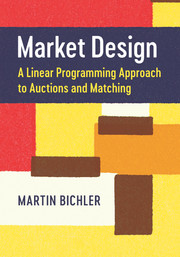Book contents
- Frontmatter
- Dedication
- Contents
- 1 Introduction
- Part I Microeconomic Fundamentals
- Part II Multi-Object Auction Design
- 5 An Overview of Multi-Object Auctions
- 6 The Simultaneous Multi-Round Auction Format
- 7 Sealed-Bid Multi-Object Auctions
- 8 Open Multi-Object Auctions
- 9 The Combinatorial Clock Auction Formats
- Part III Approximation and Matching Markets
- Part IV Appendices: Mathematical Optimization
- References
- Index
9 - The Combinatorial Clock Auction Formats
from Part II - Multi-Object Auction Design
Published online by Cambridge University Press: 08 December 2017
- Frontmatter
- Dedication
- Contents
- 1 Introduction
- Part I Microeconomic Fundamentals
- Part II Multi-Object Auction Design
- 5 An Overview of Multi-Object Auctions
- 6 The Simultaneous Multi-Round Auction Format
- 7 Sealed-Bid Multi-Object Auctions
- 8 Open Multi-Object Auctions
- 9 The Combinatorial Clock Auction Formats
- Part III Approximation and Matching Markets
- Part IV Appendices: Mathematical Optimization
- References
- Index
Summary
Combinatorial clock auctions (CCAs) have been adopted in spectrum auctions (Bichler and Goeree, 2017) and in other applications for their simple price-update rules. There are single-stage and two-stage versions, which have been used in spectrum auctions worldwide. We devote a chapter to CCAs because of their practical relevance, as for chapter 6 on the SMRA. We will discuss both versions and a practical example of a market mechanism that includes a discussion of activity rules, which are sometimes ignored in theoretical treatments.
The Single-Stage Combinatorial Clock Auction
The single-stage combinatorial clock auction (SCCA) is easy to implement and has therefore found application in spectrum auctions and in procurement. In this section we provide a more detailed discussion of the SCCA, as introduced by Porter et al. (2003), and give an algorithmic description in algorithm 3.
Auction Process
In this type of action, prices for all items are initially zero or at a reserve price r. In every round bidders identify a package of items, or several packages, which they offer to buy at current prices. If two or more bidders demand an item then its price is increased by a fixed bid increment in the next round. This process iterates. The bids which correspond to the current ask prices are called standing bids, and a bidder is standing if she has at least one standing bid. In a simple scenario in which supply equals demand, the auction terminates and the items are allocated according to the standing bids.
If at some point there is an excess supply of at least one item and no item is overdemanded, the auctioneer determines the winners to find an allocation of items that maximizes his revenue by considering all submitted bids. If the solution displaces a standing bidder, the prices of items in the corresponding standing bids rise by the bid increment and the auction continues. The auction ends when no prices are increased and bidders finally pay their bid prices for the winning packages. We will analyze a version that uses an XOR bidding language.
- Type
- Chapter
- Information
- Market DesignA Linear Programming Approach to Auctions and Matching, pp. 167 - 186Publisher: Cambridge University PressPrint publication year: 2017



